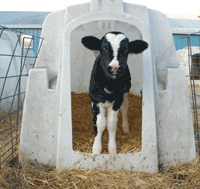As we patiently wait for the snow and ice to melt we can't forget about our calves. Calves can experience cold stress at temperatures well above freezing, and therefore will be susceptible to cold stress for many months to come.
 "It's a common misnomer for people to believe that it has to be freezing for their calves to experience cold stress," says Dr. Tom Earleywine, technical services director for Land O'Lakes Animal Milk Products. "Calves can in fact experience cold stress at much warmer temperatures." Calves less than three weeks-of-age can experience cold stress at temperatures just below 60 degrees F. Calves greater than 21 days-of-age can experience cold stress at 42 degrees F.
"It's a common misnomer for people to believe that it has to be freezing for their calves to experience cold stress," says Dr. Tom Earleywine, technical services director for Land O'Lakes Animal Milk Products. "Calves can in fact experience cold stress at much warmer temperatures." Calves less than three weeks-of-age can experience cold stress at temperatures just below 60 degrees F. Calves greater than 21 days-of-age can experience cold stress at 42 degrees F. A look at the five-year averages for ambient temperatures year-round across the U.S., show us that three week-old calves in Wisconsin and New York could experience cold stress 247 and 243 days of the year, respectively. And, while it might be easier to accept that calves in Wisconsin and New York are susceptible to cold stress - they aren't alone. Calves from California could experience cold stress 181 days of the year.
It's not just newborns either; older calves are just as susceptible. Temperatures show us that calves greater than 21 days-of-age could experience cold stress 149 days of the year in Wisconsin, 142 days in New York, 117 in Idaho and 110 in Pennsylvania.
"It's crucial that you know the average number of days per year in your state where calves experience cold stress. Don't be fooled into thinking because you live in a warm weather state your calves aren't susceptible," says Earleywine. "Plan your feeding program to provide the additional energy needed during these cold stress periods."
Here's a look at why
Newborn calves are born with minimal energy reserves. Because calves have a higher surface-area-to-bodyweight ratio than older animals, they become cold-stressed at fairly moderate temperatures. At temperatures below the thermoneutral zone, calves start to expend their internal energy reserves simply to maintain their core body temperature of 102 degrees F. The result; energy resources are diverted from growth and immune function, meaning calves will not gain weight and are more susceptible to disease like pneumonia and scours.
The thermoneutral zone for Holstein calves three weeks of age is 60 to 82 degrees F, but at temperatures below 60 degrees F, calves have to increase energy expenditure to maintain body temperature. As noted earlier, calves older than 21-days-of-age can become cold stressed at approximately 42 degrees F depending on insulation and rumen function. "Consider that when an 88-pound newborn calf has to start mobilizing its own fat stores to stay warm, it has less than one day's worth of energy 'in the bank,'" explains Earleywine.
What can you do?
To help calves survive and thrive, nutrition is the first line of defense. Therefore, implement a feeding program that supports increased energy demand, as energy is the limiting factor to calf performance during times of cold stress.
- Take a close look at your calf milk replacer. The primary sources of energy in milk replacer are fat and carbohydrates (lactose), both are needed by the calf.
- Feed calves a minimum of two gallons of liquid nutrition each day. Calves fed a "maintenance" diet (less than 1.8 pounds of milk replacer daily) are more likely to fall behind on weight gain and be susceptible to disease. Lactose provides immediate energy and fat helps to build an energy reserve for the calf. Oxidation of this reserve when the calf experiences cold stress can be the difference between a calf that thrives and one that doesn't.
- Consider adding a third feeding of milk replacer. Incorporating a third feeding of milk replacer, preferably late in the evening, provides extra energy for young calves. Research shows that calves fed three times a day have shown improved growth, better feed efficiency, consume more starter prior to weaning and have greater chance of survival to lactation than calves fed twice daily.
So don't forget, even though the snow may soon be gone, your calves can still experience cold stress for many months to come.
Since 1951, when Land O'Lakes Animal Milk Products Company developed the first calf milk replacer, the company has been committed to creating the best milk replacers from the best technologies and quality ingredients. Land O'Lakes Animal Milk Products Company is a division of Land O'Lakes, Inc. a national farmer-owned food and agricultural organization.
Download images including a side bar that takes a look at the five-year average ambient temperature in the top dairy states across the country.
2.28.2012